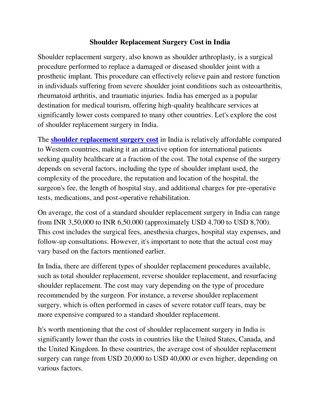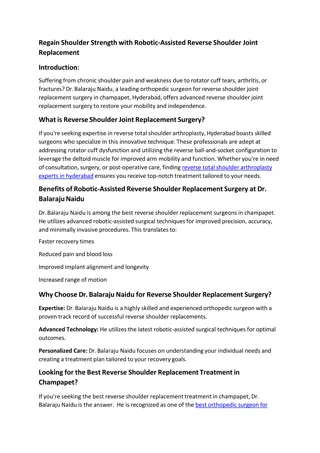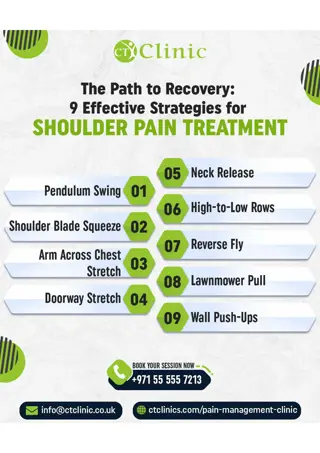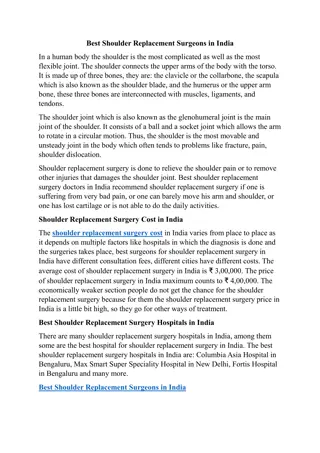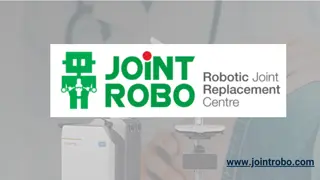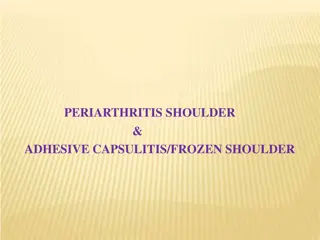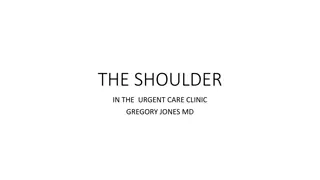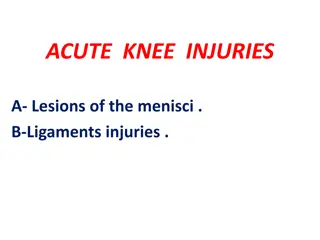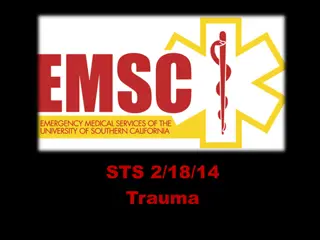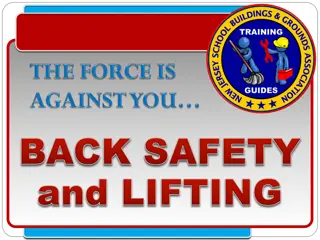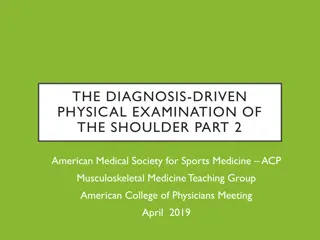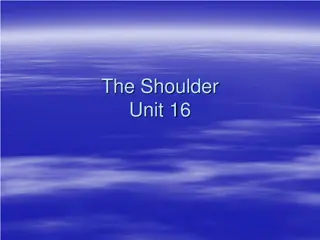Shoulder Anatomy and Rotator Cuff Injuries
Shoulders are complex joints made up of the humerus, clavicle, and scapula, with three key joints - the glenohumeral, acromioclavicular, and sternoclavicular. The rotator cuff, consisting of four muscles, plays a crucial role in shoulder function. Rotator cuff injuries like tears or tendonitis are common and can be managed through various treatments like posture reeducation, strengthening exercises, and manual therapy.
Download Presentation

Please find below an Image/Link to download the presentation.
The content on the website is provided AS IS for your information and personal use only. It may not be sold, licensed, or shared on other websites without obtaining consent from the author.If you encounter any issues during the download, it is possible that the publisher has removed the file from their server.
You are allowed to download the files provided on this website for personal or commercial use, subject to the condition that they are used lawfully. All files are the property of their respective owners.
The content on the website is provided AS IS for your information and personal use only. It may not be sold, licensed, or shared on other websites without obtaining consent from the author.
E N D
Presentation Transcript
Shoulder anatomy Three Bones: Humerous, clavicle, and scapula Three Joints: Glenohumeral, acromioclavicular, and sternoclavicular
Rotator Cuff What is the rotator cuff injury? glenohumeral compression, rotation and dynamic stability The Rotator cuff is made up of: supraspinatus, infraspinatus, teres minor, and subscapularis (SITS) Shoulder pain is the worst pain What type of joint is the shoulder (glenohumeral joint)? Ball and socket
Function of SITS Supraspinatous Abduct the shoulder Stabilize the head of humerus in the glenoid Infraspinatous Lateral rotate Adduct the shoulder Stabilize the head of humerus in the glenoid Teres Minor Lateral rotate Stabilize the head of humerus in the glenoid Subscapularis Medially rotate Stabilize the head of humerus in the glenoid.
Rotator Cuff tear/tendonitis Degenerative process More prevalent with advancing age Not all RC tears require surgury Complete tear/partial tear usually occur with increasing age of populations Muscle imbalance and capsular tightness impact the rotator cuff pathology and outcomes.
Treatment? Posture reeducation ROM PROM,AAROM, AROM Strengthening Education proper positioning (Support elbow while driving). PAMs. Manual therapy
RC no tear/small tear PROM and AAROM are initiated May present with limited shoulder flexion and internal rotation. Phase 1: forward flexion and ER supine (minimizes excessive tension) Phase 2: extension, internal rotation and cross-body stretches.
Shoulder Impingements Excessive and repetitive contact of the greater tuberosity of the humeral head with the posterosuperior aspect of the glenoid when it is repetitive abduction and external rotation. Subscapularis: Between the coracoid process and lesser tuberosity Also identify as in the impingement category.
Importance of the scapula Main stabilizers Levator scapula, rhomboid, serratus anterior, and trapezius Improve scapular stabilization= better posture=more functional during ADL/IADL tasks. Scapular plays major role in shoulder function.
Scapulohumeral rhythem First 30 degrees of shoulder abduction, the scapular remains stationary For every two degrees of glenohumeral movement, for every 1 degree of scapulothoracic movement
Question What nerve is involved with scapular winging: A.) Thoracodorsal nerve B.) Axillary C.)Long thoracic nerve
Question What are the movements of the scapula: Elevation/depression, protraction/retraction, IR/ER, anterior/posterior tilt.
Question What two joint are under the most stress if a person has a hunch-over posture SC and AC
Question What does a kyphotic posture look like?
Question What provocative test is this?
Question What pathology does the speed s test test for? Long head of the biceps and superior glenoid labrum
Frozen Shoulder Other name for FS -Adhesive Capsulitis Freezing Phase -Pain starts with sleep and ADL tasks -Client tends to limit movement due to an increase in pain Frozen Phase -This may last up to a year and compensate for GH by substituting ST motion Thawing Phase -Can last up to 26 months. Recent study shows 90% of patients have return full motion when compared to their contralateral side.
Thoracic Outlet Syndrome (TOS) Compression can happen at: Scalene triangle, costoclavicular space, and pec minor Vascular damage is uncommon (3% to 5%) Majority of TOS is brachial plexus related.
Question An OTR receives an order to work on a nonresistive exercise program with a patient who had a shoulder fracture 2 weeks ago. Initial OT treatment should include: A. pendulum exercises B. active ROM C. weight bearing exercises D. isotonic strengthening
Question An OTR is treating a patient who has a C6 complete spinal cord injury. The patient demonstrates Fair plus (3+/5) strength in scapular depression and Fair (3/5) should flexion and abduction bilaterally. The patient s goal is to be able to sit at the edge of the bed independently. The best compensatory strategy for this patient to use would be full wrist extension along with shoulder: A.)depression, protraction, and external rotation B.)elevation, protraction, and external rotation C.)elevation, retraction, and internal rotation D.)depression, retraction, and internal rotation
Question During an upper extremity assessment, a patient demonstrates 45 degrees of active shoulder flexion while in a seated position. The OTR is able to passively move the limb through the full ROM. To accurately grade the strength of this muscle group, the OTR should NEXT: A.)apply resistance in midrange with the shoulder in the frontal plane B.)apply resistance in midrange to the opposing muscle groups C.)determine the end-feel of the glenohumeral joint D.)determine active motion in a gravity-eliminated position
Question 6. A patient who had a left CVA a month ago reports constant pain in the right arm. The OTR notes that the patient s right hand is hypersensitive and the skin is mottled. This condition is indicative of: A.)a hand contracture B.)complex regional pain syndrome C.)a brachial plexus injury D.)thalamic pain syndrome
Question A patient who has had a CVA has mild motor and sensory loss in the upper extremity. The patient tells the OTR that the lotion being provided for sensory input is causing a skin rash. The OTRs best response would be to: A.)have the patient rinse with water after using lotion B.)refer the patient to an allergist C.)use alternating heat and cold prior to applying lotion D.)rub the arm with objects of varied textures instead of lotion
Question Email: tutorcory.passtheot@gmail.com



